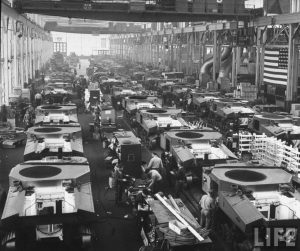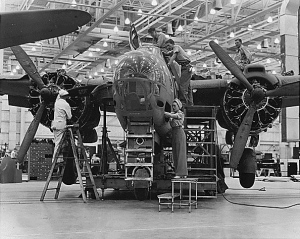How did World War II influence the spike in manufacturing?
Post World War II, the world saw a massive economic spike. This can be attributed to increased demand for products, new technologies, and global sociopolitical factors. A major part of that was an increase in manufacturing production throughout the world, and most notably in the U.S., France, West Germany, Italy, and Japan.
How did this spike happen? There were a number of factors involved that we’ll look at here.

A B-29 Superfortress Factory during World War II in the United States. During World War II, 11,000 supermarkets opened in the United States and 2 million American women went to work in factories. Image Source
Pre-war conditions
Before WWII (and after WWI), the world was going through a depression. The Great Depression had increased unemployment in the United States to 25%, and other nations were suffering as well.
This economic depression had left factories empty, which set the stage for the resurgence in production during and after WWII.
The war’s impact on manufacturing in the U.S.

A tank factory in the United States, photographed in 1942. Image Source
The United States saw an incredible economic shift after the war. Some of the factors that contributed to increases in production included the following:
Increased demand
During the war, there was increased demand from businesses to manufacture supplies for the war effort. Factories filled up, and production skyrocketed. Between 1939 and 1944, the nation’s gross domestic product increased by roughly 8% each year.
New technologies and products during World War 2
New industries such as computers, television, commercial aviation, and the like were introduced and improved during the war. With new technology comes new production lines, and thus an increase in manufacturing.
Other industries became more mechanized. Agriculture, for instance, saw increased use of tractors, combine harvesters, and various chemicals. Production lines became more automated with new control technology.

A factory in the United States during World War II shows women working on an aircraft. In the first 16 months of WWII, 318,000 aircraft came out of factories in the United States. Image Source
Wealth redistribution
Progressive tax rates were introduced during the war to enable government investment in the war effort. After the war was over, that tax structure persisted, and the government invested in numerous projects, such as the Interstate Highway System in 1956.
Increased standard of living during World War 2
Easier access to new technologies and property led to the expansion of the middle class. People lived in greater comfort, purchased more goods, and thereby supported production throughout the nation.
World War 2’s global impact on technology
Naturally, the war’s impact extends well beyond the United States. Many of the advances in technology and production seen in the U.S. were also seen in Europe and Japan, causing increases in industrial production.
Cooperation between nations
The spike in manufacturing was also helped by the increased cooperation seen among nations. Several countries formed the European Coal and Steel Community (ECSC), which helped facilitate modernization and reduced costs to its members.
The ECSC was the foundation for the United Nations, which formed later on.
Other factors
Additional factors that affected production include:
- Lower oil prices, facilitating the switch from coal to fossil fuels
- Financial repression, which affected interest rates and affordability
- Depopulation, which freed up resources and lowered the prices of commodities
Summary
Ultimately, the spike in manufacturing after the war resulted from:
- Increased demand
- New products
- Changes in government policies
- Global economic factors
- International cooperation
That spike lasted until the 1970s, and it has affected manufacturing to this day.
Want to keep reading?
Does our society today put too much of an emphasis on innovation rather than maintenance?
What are some of the future innovations in facility management?
What are the top 10 hotel chains in the United States that are innovating maintenance?
4,000+ COMPANIES RELY ON ASSET OPERATIONS MANAGEMENT
Leading the Way to a Better Future for Maintenance and Reliability
Your asset and equipment data doesn't belong in a silo. UpKeep makes it simple to see where everything stands, all in one place. That means less guesswork and more time to focus on what matters.


![[Review Badge] GetApp CMMS 2022 (Dark)](https://www.datocms-assets.com/38028/1673900459-get-app-logo-dark.png?auto=compress&fm=webp&w=347)
![[Review Badge] Gartner Peer Insights (Dark)](https://www.datocms-assets.com/38028/1673900494-gartner-logo-dark.png?auto=compress&fm=webp&w=336)
